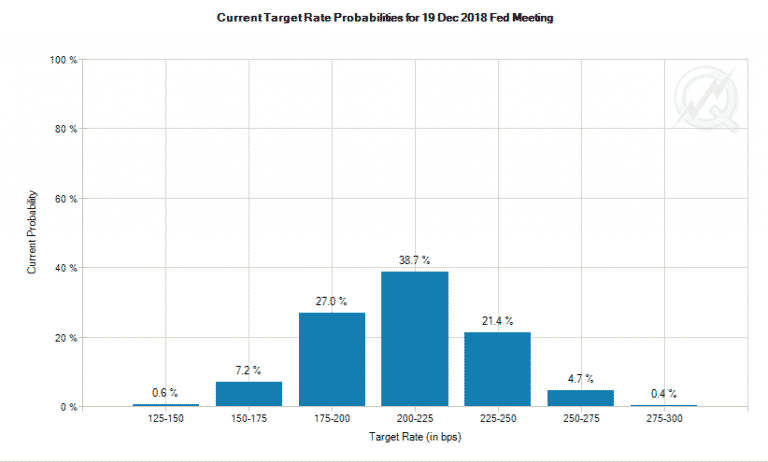Yesterday, after the inflation report came out, I wrote that as inflation expectations increase, the interest rates investors will accept will climb slowly. Equity markets won’t throw a fit at 2.85% interest rates as they did just recently. Instead though, it could be smooth sailing until 10-year interest rates hit 3.00%. And then we see more market volatility. But once that level settles in, the acceptable rate might climb to 3.25%. And we will repeat the process all over again.
This is how late-cycle interest rate hike regimes work. But at some point, there will be a negative impact on credit and that will feed through into the real economy. That’s the view I presented last night when I spoke to Peter Armstrong on CBC’s on the Money program. Below is the video clip. But let me expand my comments here.
Timeline of market correction: interest rates key
US equity markets topped out on January 26th. And the narrative that had been building as the year began was of an equity bubble accompanied by a bond bear market. Fund managers Jeremy Grantham and Ray Dalio talked of a meltup in equities, followed by a meltdown. And bond market pros like Jeff Gundlach and Bill Gross said that US treasuries were entering a period of sustained losses.
The problem with this narrative was the view that the two market moves could proceed without triggering increased volatility. And volatility was triggered almost immediately, with 10-year Treasury yields still at 2.66% as the market topped on Friday, January 26th.
As the market proceeded the next week, equities went down as bond yields went up. The moves were moderate, but the VIX volatility index still rose. At the end of that week, when the employment report came out, showing a large headline increase in average hourly earnings, inflation fears dominated. The 10-year Treasury went to 2.85%. Equities plummeted and the VIX soared into a weekend close.
This chain of events is what precipitated the heavy selling at the beginning of last week. Much of it was driven by the increase in volatility. When volatility measures increased, it forced selling due to a crowded short-volatility trade that had built over months.
What to expect from earnings going forward
The question now is whether the short volatility trade has been driven out of markets. I suspect it has not been. And that means that this trade will continue to amplify down moves in equity markets.
But overall, it has been a good quarter for corporate earnings. Through last week, 80% of the S&P 500 companies had reported earnings. 74% beat estimates, with an average beat of 4.8%. And average earnings per share grew 15.8% in the quarter. We should expect this to continue given the positive economic backdrop. Corporate tax cuts will also bolster earnings.
Therefore, the only thing that should hold earnings back is a contraction in the earnings multiple or an unexpected negative economic turn. Rising bond yields could certainly trigger a contracting multiple by raising the rate at which future earnings are discounted. But a downturn in the business cycle is what everyone fears.
Credit and credit writedowns crucial as always
Right now, banks are arguably over-reserving for bad loans. The default rate is so low that the accounting adjustment banks make to prepare for defaults exceeds actual defaults. This is what we see when the economy is doing well.
However, when loans go bad beyond the rate that financial institutions are prepared to handle, these credit writedowns negatively impact bank capital. As a result, credit growth slows. And once credit growth slows, economic growth slows. Since we are nine years into this cycle, any slowing now would likely trigger recession.
So, the poor retail sales number yesterday was a fly in the ointment. It could point to consumer exhaustion. And indeed, some of the credit sectors that have most pushed up growth are showing signs of exhaustion.
Oil prices are flagging. And this could point to slowing demand growth. Right now, oil analysts point to increased supply as the probelm there. Even so, if prices drop enough and stay down long enough, this could be a problem sector.
Another big credit sector to watch in the US is the auto sector. Auto sales are down as are average new vehicle prices. Former Fed official Danielle DiMartino Booth has told me that this is one sector she is watching for early warning signs.
We should only become concerned if these declining fundamentals result in rising defaults and credit writedowns. This is when credit in the sector becomes an issue and the sector begins to subtract from growth. For example, oil prices had declined significantly from mid-2014 before shale oil firms began to default.
At some point, the Fed will increase interest rates enough to create distress among debtors. When those debtors default because of distress, we can start to worry about slowing credit growth feeding into slowing economic growth.
Expect interest rates to continue up
Until we see these signs of credit distress, slowing credit growth or slowing growth, interest rates will likely rise. That’s because the bond markets have only priced in 63% of the Fed’s stated policy guidance for three rate hikes through the December 2018 meeting.

If the data continue to show growth in the economy, this probability will go up. And when markets move toward the Fed, rates will rise. The big question is how much do rates have to rise before it causes angst in equity markets or distress in credit markets. The recent equity market correction was the first sign that the march higher in yields will be a bumpy ride. We should expect more volatility as the rate increases proceed.
Comments are closed.